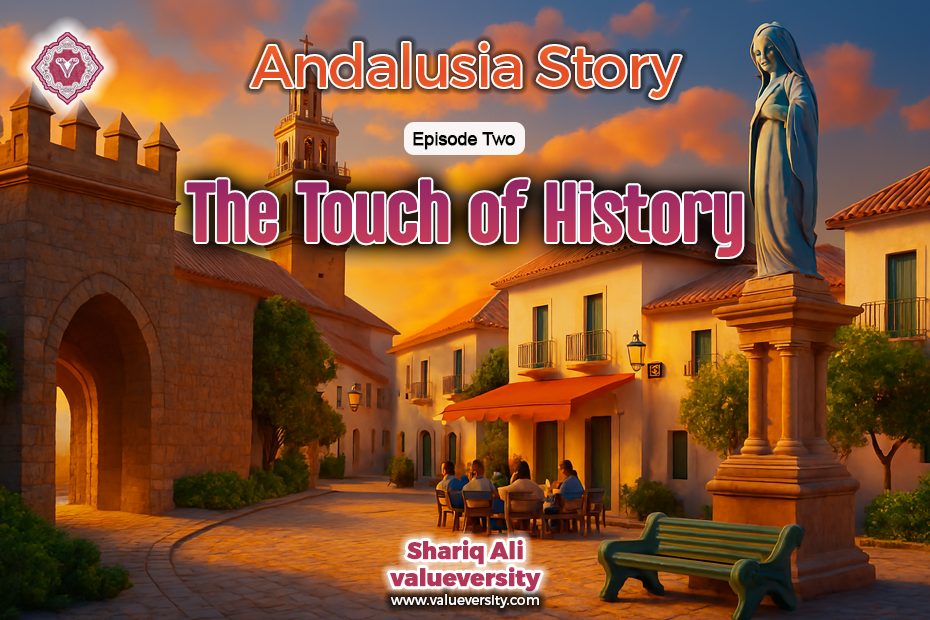The Touch of History The Andalusia Story: Episode Two
Written by: Shariq Ali
Valueversity
Walking alongside the awe-inspiring walls of the Alcázar Palace, we entered a narrow but charming alley. The stone-paved street still preserved the touch of its thousand-year-old history. The soft twilight of dusk had spread its arms across the palace walls.
The scene was lively, filled with the hustle and bustle of both local and foreign tourists.
At the end of this alley, we reached an Arabic restaurant named Restaurante Al Medina.
This restaurant had received excellent reviews on the TripAdvisor app, especially for its traditional dishes from Saudi Arabia and other Arab countries.
As we entered, the ambiance felt just like that of a restaurant in a Gulf city. Arabian paintings adorned the walls, lantern-style lights hung from the ceiling, and soft Gulf-inspired music played in the background.
The menu gleamed with names of famous Arabic dishes such as Lebanese Shawarma, Saudi Kabsa, Falafel, and Hummus.
We chose a special dish that consisted of tender and flavorful pieces of chicken, harmoniously cooked with assorted vegetables on low heat.
The mild use of spices and the dish’s exquisite taste transported us to the streets and bazaars of Arabia.
We enjoyed our meal peacefully and with great delight.
After paying the bill and promising to leave a good review, we left the restaurant. Walking alongside the palace walls again, we reached a nearby famous square called Plaza del Triunfo.
This square is well-known for its marble monument, Immaculate Conception Monument, representing the Virgin Mary.
Locals and tourists often sit on the benches here to rest. By now, the night had fully embraced everything around us.
The beautifully styled lights in the square created a dreamy scene.
We sat on one of the benches near the statue of the Virgin Mary.
In front of us stood a beautiful shopping center, whose shops had all closed for the day, though their neon signs still glowed brightly.
Behind us stood a five-star hotel, housed within a historic building.
We enjoyed a few moments of silence in this serene atmosphere.
As we got up to head back to our hotel, we realized we didn’t have the energy to walk another 20 minutes.
So, we booked a taxi through the Uber app and headed back to the hotel.
Tonight, we wanted to sleep early since we had planned to travel to Córdoba the next morning.
After reaching the hotel, we surrendered ourselves to sleep.
The alarm woke us at 7 a.m.
Following our morning routines and breakfast at the hotel, we packed our bags and reached the pre-arranged square located in front of Hotel De Park.
Soon, many tourists like us started to gather there.
Two uniformed representatives from the tourism company warmly welcomed us, checked our pre-purchased tickets, and guided us to our designated spots.
These two gentlemen were the epitome of professional courtesy—something quite common across Europe.
It became clear how well-organized and strong Spain’s tourism industry is.
After a short wait, a luxury coach arrived.
The driver was a woman.
Though her name escapes me, her skill and confidence remain unforgettable.
She drove the large, passenger-filled luxury coach with the ease of operating a sewing machine.
Among the passengers, about half were locals and the other half foreign tourists.
Seated next to us was a cheerful, elderly American couple.
Tim had been a physical coach at a school and had even trained some Olympic athletes during his career.
His humorous and gentle tone suited his towering personality perfectly.
His wife, Valerie, had taught French to children at a school before retirement.
Another couple, seated near us, hailed from South India.
They were soft-spoken yet polite.
We conversed in English since, being South Indian, they spoke Telugu and were not familiar with Hindi.
The coach stopped in front of several well-known hotels in the city to pick up more passengers.
Soon after, we left Seville’s city limits and entered the suburban areas.
On our way, we passed by Seville’s suburbs such as San Juan de Aznalfarache, Tomares, and Camas.
These areas seemed like a delightful blend of modern and traditional architecture, with residential neighborhoods alongside shopping centers and lush green parks.
Then the scenery changed, and we entered the traditional rural areas of Andalusia.
Expansive olive groves, vineyards, and undulating green fields stretched out before us, offering a stunning display of natural beauty.
The prosperity of this land can never forget its debt to the Muslims.
It was here, in the 8th century, that Muslims ushered in an agricultural revolution.
Muslim engineers laid out intricate canal systems, water wheels, and underground aqueducts that transformed barren lands into fertile fields.
Crops like olives, almonds, wheat, and citrus fruits—lemons, oranges, and mandarins—turned Andalusia into Europe’s agricultural heartland.
Even today, at least to my eyes, the effects of that cultural innovation and hard work are clearly visible in the region’s landscapes.
Our coach was smoothly moving forward, and we were now approaching our destination—Carmona, the Muslim Qarmunah…
(To be continued)
